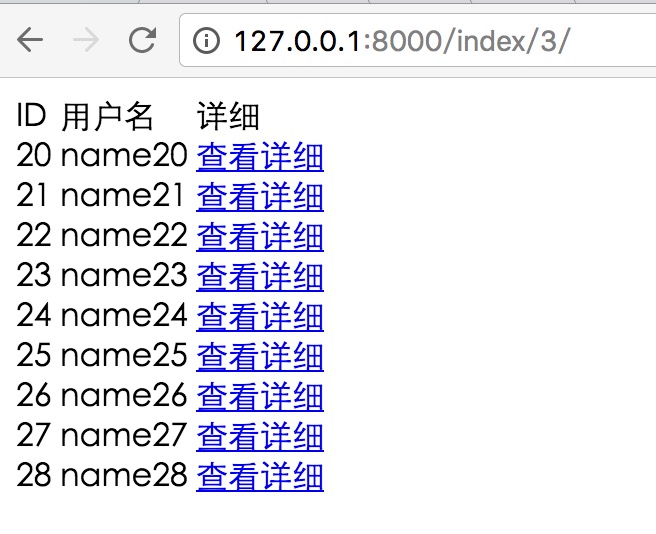一、路由系统介绍
在django程序中,可以通过urls.py文件对所有的url进行任务的分配,根据路由规则的定义选择不同的业务处理函数进行处理
二、路由规则定义
1、路由规则代码如下,mysite/mysite/urls.py
from django.conf.urls import url, include
from django.contrib import admin
from cmdb import views
urlpatterns = [
#####静态路由#####
# ① 匹配规则 http://127.0.0.1:8000/index/*
url(r'^index/', views.index),
#####动态路由--利用正则表达式可以达到分页url的效果#####
# ② 匹配规则 http://127.0.0.1:8000/detail/432432 将最后面的数字当做参数传递给views.detail函数的nid参数
url(r'^detail/(d+)', views.detail),
# ③ 匹配规则 http://127.0.0.1:8000/detail2/432432/2 将最后面的两个数字当做参数分别传递给views.detail函数的nid和nnid参数
url(r'^detail2/(d+)/(d+)', views.detail2),
# ④ 匹配规则 http://127.0.0.1:8000/detail3/432432/2 将最后面的两个数字根据自定义的名字当做参数分别传递给views.detail函数的p1和p2参数
url(r'^detail3/(?P<p1>d+)/(?P<p2>d+)', views.detail3),
#####路由分发#####
# 当一个网站变得庞大之后,在一个project中就会存在很多的路由规则,可以使用路由分发将每个APP的路由规则分发至APP自己的路由规则进行处理
# 通过include可以将以web开头所有的url都分发给web.urls中的路由去进行处理
url(r'^web/', include("web.urls")),
]
2、业务处理函数的代码如下, mysite/cmdb/views.py
from django.shortcuts import render
from django.shortcuts import HttpResponse
# Create your views here.
def index(request):
return render(request, "index.html")
def detail(request, nid):
print(nid)
return HttpResponse("OK")
def detail2(request, nid, nnid):
print(nid, nnid)
return HttpResponse("OK")
def detail3(request, p1, p2):
print(p1, p2)
return HttpResponse("OK")
3、程序目录结构
mysite/
├── cmdb
│ ├── admin.py
│ ├── apps.py
│ ├── __init__.py
│ ├── migrations
│ │ └── __init__.py
│ ├── models.py
│ ├── tests.py
│ └── views.py
├── db.sqlite3
├── manage.py
├── mysite
│ ├── __init__.py
│ ├── settings.py
│ ├── urls.py
│ └── wsgi.py
├── static
│ └── s1.css
└── templates
└── index.html
三、动态路由的应用 -- 实现分页和详细信息的功能
1、路由规则代码 mysite/mysite/urls.py
from django.conf.urls import url
from cmdb import views
urlpatterns = [
url(r'^index/(d+)/', views.index), # 分页
url(r'^detail/(d+)/', views.detail), # 详细信息
]
2、业务处理函数代码 mysite/cmdb/views.py
from django.shortcuts import render
from django.shortcuts import HttpResponse
# Create your views here.
# 临时存放一些数据,生产环境中,这些数据都是保存在数据库中
USER_LIST = []
for item in range(108):
temp = {"id": item, "username": "name"+str(item), "email": "email"+str(item)}
USER_LIST.append(temp)
def index(request, page):
# 将用户信息分页展示
print(page)
# 第一页 0-9
# 第二页 10-19
# 第三页 20-29
page = int(page)
start_id = (page - 1) * 10
end_id = page * 10 -1
user_list = USER_LIST[start_id:end_id]
return render(request, "index.html", {"user_list": user_list})
def detail(request, nid):
# 用户ID的详细信息
nid = int(nid)
current_detail_dict = USER_LIST[nid]
return render(request, "detail.html", {"current_detail_dict": current_detail_dict})
3、分页html代码 mysite/templates/index.html
<!DOCTYPE html>
<html lang="en">
<head>
<meta charset="UTF-8">
<title>Title</title>
<link rel="stylesheet" href="/static/s1.css">
</head>
<body>
<table>
<thead>
<tr>
<td>ID</td>
<td>用户名</td>
<td>详细</td>
</tr>
</thead>
<tbody>
{% for item in user_list %}
<tr>
<td>{{ item.id }}</td>
<td>{{ item.username }}</td>
<td><a href="/detail/{{ item.id }}/" target="_blank">查看详细</a></td>
</tr>
{% endfor %}
</tbody>
</table>
</body>
</html>
4、用户详细信息html代码 mysite/templates/detail.html
<!DOCTYPE html>
<html lang="en">
<head>
<meta charset="UTF-8">
<title>Title</title>
<link rel="stylesheet" href="/static/s1.css">
</head>
<body>
<ul>
<li>{{ current_detail_dict.id }}</li>
<li>{{ current_detail_dict.username }}</li>
<li>{{ current_detail_dict.email }}</li>
</ul>
</body>
</html>
5、目录结构
mysite/
├── cmdb
│ ├── admin.py
│ ├── apps.py
│ ├── __init__.py
│ ├── migrations
│ │ └── __init__.py
│ ├── models.py
│ ├── tests.py
│ └── views.py
├── db.sqlite3
├── manage.py
├── mysite
│ ├── __init__.py
│ ├── settings.py
│ ├── urls.py
│ └── wsgi.py
├── static
│ └── s1.css
└── templates
├── detail.html
└── index.html
6、访问用户信息分页url,点击页面查看详细
-
通过访问url http://127.0.0.1:8000/index/3/ 最后的数字可以换成其他的

-
点击用户信息分页中的对应用户信息中的查看详细
